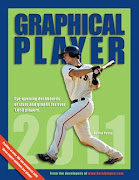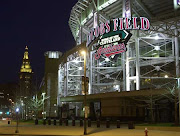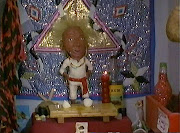A shift was on for Hank Blalock, moving Jhonny Peralta to the shortstop position and Cabrera over to the first base side. Blalock hit a ground ball about a foot left of the bag, directly between the two infielders. Running at full speed to make a play on the ball, neither player appears to see each other until it’s too late. In an attempt to slow down at the last second, Peralta slides into and on top of Cabrera, placing Cabrera’s arm in an awkward position underneath his torso and causing the fractured bone.
I was ready to place the blame on Peralta for the incident (which I’m sure was the knee-jerk reaction for a lot of fans), but upon further review, there really wasn’t anything Peralta could have done to avoid the collision once the play began. Below is a series of screenshots showing the play in question:
Normally, if Peralta and Cabrera were converging on a ball, their routes would overlap with one backing up the other. Because of the shift and the direction the ball took towards second base, their ranges overlapped.

Here, you can see Peralta and Cabrera converging on the ball at nearly the same time. Both are focused on the ball and getting ready to make a play and fail to notice the other player bearing down on them.
After watching the replay several times, I think this is the point where the play broke down and turned dangerous. Some may blame Peralta’s inability to get out of the way in time or point out that the shortstop should have received priority on the play, but the collision resulted from a lack of communication and the departure of the standard infield procedures. This is partly due to the unusual circumstances presented by the shift.
To my knowledge, infielders don’t typically call out for a ground ball, it just reverts to whoever is closest to the area of play at the time. An initial verbal cue could have prevented the collision, though such an act is far from second nature for a ground ball up the middle. Cabrera may have been a few steps closer to where the ball rolled through, but it was very close; arguably too close for the players to reasonably judge in the middle of a quick play like that. However, they did have an opportunity to either discuss the shift with each other or note where people were positioned prior to that first pitch to Blalock. It’s unclear whether this actually happened or not.
Both players are still looking over their shoulder at the ball and not paying attention to each other. Peralta seems to be taking a route slightly behind Cabrera.
At this point, Peralta notices Cabrera diving towards him at an angle to cut off the ball and he attempts to put on the brakes. Keep in mind that they are both going at full tilt right now.
Peralta tries to skid to a halt on his knee, but his momentum continues to carry him…
...until he briefly rolls over Cabrera. It appears that Peralta was able to avoid dropping his full weight onto Cabrera, propping himself up with his knee. Unfortunately, Cabrera’s arm is trapped between the ground and the point where Peralta’s weight does land, which places too much stress on the bone and fractures it.
Again, I feel that blame for the collision lies with both players, even though Cabrera took the hit. There are measures each player could have taken collaboratively or on his own to prevent the accident, yet presumably failed to do so. The severity of Cabrera’s injury still seems like a fluke to me though. If I had watched the replay without knowing the aftermath, I would have been surprised to hear it caused a broken arm. There just didn’t seem to be enough contact or force involved.
That said, I feel absolutely terrible for Cabrera. He had begun to establish himself as a key member of the team as starting shortstop and leadoff hitter this season, only to have it derailed early on. Last season, Cabrera missed nearly a month after dislocating his shoulder while sliding into second to break up a double play. Both were fairly routine plays that for whatever reason, ended in a serious injury.
Is Cabrera at risk of developing into one of those brilliant, yet fragile players during his career? Even though he was a starter for all of 2009, Cabrera was only healthy enough to appear in 131 games that year. Over the course of the 2009 season, he suffered a hip strain, ankle injury (running out to his position between innings), knee contusion (fouled off a ball), the dislocated shoulder, and had surgery to remove loose bodies in his elbow after the season. So far in 2010, he’s had a strained groin in spring training, a quad strain, and the broken arm. All those little injuries are seemingly starting to pile up for the 24-year-old shortstop.
I think it’s still too early to write off Cabrera as a chronic injury risk, partly due to his age and the unavoidable or routine nature of some of the injuries. Plus, a major item was overlooked in the list above: how much time was actually missed from these injuries. It may be a lengthy list compared to some players, but it’s not nearly as bad as it seems. Twenty five of the games he missed in 2009 resulted solely from the dislocated shoulder. Had he not collided with the infielder’s leg on that play, Cabrera would have appeared in at least 156 games (that’s over 96% of the season). If that were the case, I wouldn’t have given his injury history a second thought.














No comments:
Post a Comment